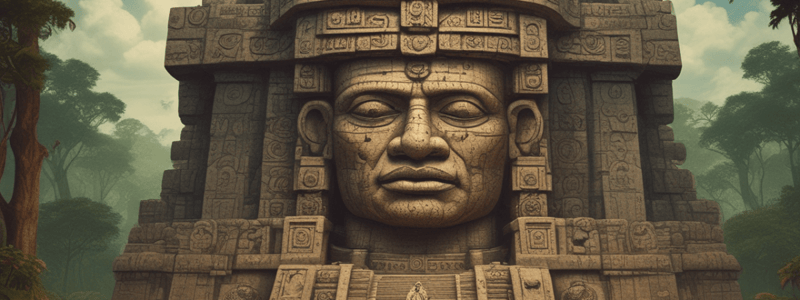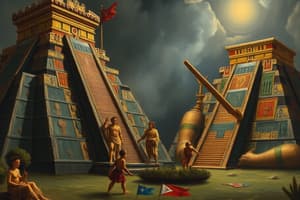Podcast
Questions and Answers
What crop was first domesticated in Mexico between 7000 BCE and 6500 BCE?
What crop was first domesticated in Mexico between 7000 BCE and 6500 BCE?
- Teosinte
- Jade
- Maize (correct)
- Cacao
What was the original source of chocolate?
What was the original source of chocolate?
- Jade
- Cacao
- Teosinte (correct)
- Maize
What was the characteristic of Olmec art style?
What was the characteristic of Olmec art style?
- Abstract and geometric shapes
- Realism and broad facial features (correct)
- Simple and minimalistic
- Realism and narrow facial features
What was the significance of jaguars in Olmec religion?
What was the significance of jaguars in Olmec religion?
What was the role of shamans in Olmec religion?
What was the role of shamans in Olmec religion?
What was the purpose of the Olmec calendar?
What was the purpose of the Olmec calendar?
What was Mathew Stirling searching for when he arrived in Veracruz, Mexico, in 1939?
What was Mathew Stirling searching for when he arrived in Veracruz, Mexico, in 1939?
What was the significance of the Olmec colossal heads?
What was the significance of the Olmec colossal heads?
What was the initial reaction of Mathew Stirling's colleagues to his discovery of the broken Olmec Stela with a partial date inscription?
What was the initial reaction of Mathew Stirling's colleagues to his discovery of the broken Olmec Stela with a partial date inscription?
What was the significance of the city of La Venta?
What was the significance of the city of La Venta?
What was the result of the Olmec influence on Mesoamerica?
What was the result of the Olmec influence on Mesoamerica?
What was the significance of the date inscription on the Olmec Stela discovered by Mathew Stirling?
What was the significance of the date inscription on the Olmec Stela discovered by Mathew Stirling?
What is a notable aspect of Mesoamerican culture that can be traced back to Olmec influences?
What is a notable aspect of Mesoamerican culture that can be traced back to Olmec influences?
What is the evidence for the claims of outside influence on the Olmec achievements?
What is the evidence for the claims of outside influence on the Olmec achievements?
Why do we not have written histories or oral traditions from the Olmec civilization?
Why do we not have written histories or oral traditions from the Olmec civilization?
What is the origin of the name 'Olmec'?
What is the origin of the name 'Olmec'?
Flashcards are hidden until you start studying
Study Notes
Here is a summary of the text in detailed bullet points:
• In 1939, Mathew Stirling arrived in Veracruz, Mexico, to excavate the site of Tres Zapotes, searching for answers about the Olmec civilization.
• At the time, not much was known about the Olmec, and scholars assumed they were a relatively recent civilization, contemporary with the classical Maya.
• Stirling suspected that the Olmec civilization was much older, but he had no proof until he discovered a broken Olmec Stela with a partial date inscription, which he and his wife Marian deduced was September 3, 32 BCE, the oldest written date ever recorded in Mesoamerica.
• Initially, their colleagues rejected the discovery as overly speculative, but later, carbon dating and the discovery of the rest of the Stela vindicated the Stirlings.
• The Olmec civilization was the first major civilization in Mesoamerica, and many aspects of Mesoamerican culture, such as calendars, ball games, and the Mesoamerican pantheon, can be traced back to Olmec influences.
• The Olmec left no written histories or oral traditions, and all knowledge about them comes from archaeology or the study of subsequent cultures.
• The name "Olmec" comes from the Nahuatl word for "rubber people," as the region's inhabitants produced rubber as far back as Olmec times.
• Before the rise of the Olmec, the people of Mesoamerica had recently begun living a sedentary lifestyle, made possible by the domestication of crops like maize, which was first domesticated in Mexico between 7000 BCE and 6500 BCE.
• The Olmec were the first civilization to have chocolate, which was originally domesticated from the teosinte plant.
• By the beginning of the second millennium BCE, civilization was taking shape in Mesoamerica, and the Olmec were a cultural juggernaut, exercising an oversized influence over Central America from 1700 BCE to the end of the first millennium BCE.
• The Olmec lived in large, planned urban settlements with elite residences, workshops, and rich, elaborate tombs, such as the city of La Venta, which thrived from 900 BCE to 400 BCE.
• La Venta has a planned layout with many temple mounds surrounding a main plaza, featuring a large rectangular pyramid with stepped sides, similar to later pyramids in Mesoamerica.
• The Olmec were masters at shaping stone, as evident in their monumental sculptures, including the colossal heads, which were carved from huge blocks of basalt and weighed over 40 tons.
• The colossal heads are thought to represent Olmec rulers, and each one is distinct, with no two portraying the same person.
• The Olmec art style is recognizable for its realism and broad facial features, and many sculptures depict people transforming into animals, such as Jaguars, which occupied an important place in Olmec religion.
• Shamans played a vital role in Olmec religion, interacting with the spiritual world by taking hallucinogens to enter an altered state of consciousness.
• The Olmec were skilled craftsmen, creating beautiful jade figurines, ritual axes, and other artifacts that have been found in burials and tombs.
• The Olmec developed a written numerical system, which allowed them to record their history in writing, a feature that was widespread and successful throughout Mesoamerica.
• The Olmec calendar was a universal feature of nearly all Mesoamerican cultures, underpinning all ceremonial and religious life.
• The Olmec also developed a written script, which remains undeciphered, but is believed to have originated in the Olmec heartland and spread throughout Mesoamerica.
• The Olmec were among the earliest cultures playing the Mesoamerican ballgame, which was a huge fixture in Mesoamerica, symbolizing the battle between good and evil and life and death.
• The Olmec expanded and traded with their contemporaries across Central America, producing rubber, cacao, salt, and manufactured goods, and trading for Jade, serpentine, obsidian, and iron ore.
• The Olmec had a strong presence in sites outside the heartland, such as Chalcatzingo in the Valley of Morelos, and Teopantecuanitlan in the state of Guerrero, which was an important trading partner due to its high-quality Jade.
• The extent of Olmec contact within Mesoamerica is evident in the many Olmec artifacts and sites found throughout Central America, sparking debate about the nature of this contact, whether peaceful or violent.- The Olmec civilization's influence did not extend beyond their realm, and areas without their influence remained uncivilized, lacking calendars, writing, science, great art, and states.
- The Olmec are at the center of many conspiracy theories, with some scholars suggesting that their achievements and art were influenced by outside forces, such as Africa, China, or Europe.
- Some theories propose that the Olmec colossal heads have African ethnic characteristics, like broad noses and full lips, as evidence of ancient African contact with Mesoamerica.
- Experts argue that these African features are also shared by the indigenous people of the Veracruz region, and that Mesoamerican pyramids have a distinct evolution in history, separate from the pyramids of Egypt and Nubia.
- There is no genetic or linguistic evidence to support these claims, and Mesoamerican scholars agree that these theories have no substantiating evidence.
- Similar conspiracy theories and pseudo-scientific literature claim that Native American achievements were influenced by European, African, or Asian civilizations, but these claims have little merit.
- The Olmec civilization was extremely successful, leaving a huge impression on Mesoamerica, with their style found everywhere, and their culture lasting over a thousand years.
- Olmec culture began to decline with the abandonment of La Venta in 400 BCE, but some later Olmec sites continued for a few more centuries before slowly fading away.
- The Olmec were pivotal in spreading the use of the Mesoamerican calendar, religion, the ballgame, and urban design, and their legacy continued to influence Mesoamerica.
Studying That Suits You
Use AI to generate personalized quizzes and flashcards to suit your learning preferences.




